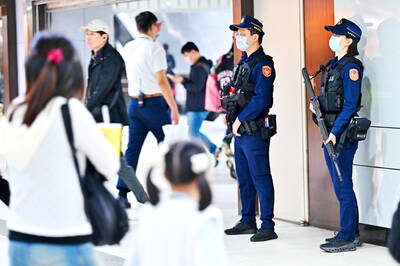The US would continue to help Taiwan bolster its ability to defend itself, American Institute in Taiwan (AIT) Director Raymond Greene said in a meeting with President William Lai (賴清德) at the Presidential Office in Taipei yesterday.
Greene assumed his new role as AIT director on Monday, serving as Washington’s top envoy to Taiwan.
“First of all, and the most important thing, the US will strongly support Taiwan’s self-defense capabilities,” Greene said.

Photo: Presidential Office via AP
“We both have common and long-term interests in peace and stability over the Taiwan Strait,” he added.
This support was in line with Washington’s long-standing policy guided by the Taiwan Relations Act, the Three Joint Communiques and the “six assurances,” he said.
Greene, who delivered his remarks in Mandarin, stressed the need to maintain peace and stability in the Taiwan Strait, describing it as a common and long-term interest of Taipei and Washington, and as extremely important for global security and prosperity.
He also said he was “confident that with the support of the global democratic community, we can safeguard Taiwan’s democracy.”
Calling Taiwan “a key partner” in promoting trade and the global supply chain resilience, Greene said he was looking forward to working with the Lai administration to advance bilateral economic, cultural and technological cooperation.
In his remarks, Lai thanked the US for showing its commitment to supporting Taiwan’s efforts to improve its security, mentioning in particular the 15 announcements of arms sales to Taiwan under the administration of US President Joe Biden.
Lai reiterated his pledge to maintain the “status quo” in the Taiwan Strait, despite increasing challenges posed by China, and expressed the hope of working closely with the US and other like-minded countries in support of the prosperity and development of the Indo-Pacific region.
As a career diplomat, Greene has previously been posted to Taiwan twice, including serving as deputy AIT director from 2018 to 2021.
Before arriving in Taiwan to take charge of the AIT, which represents US interests in Taiwan in the absence of official diplomatic ties, Greene was deputy chief of mission at the US embassy in Japan.

TRAGEDY STRIKES TAIPEI: The suspect died after falling off a building after he threw smoke grenades into Taipei Main Station and went on a killing spree in Zhongshan A 27-year-old suspect allegedly threw smoke grenades in Taipei Main Station and then proceeded to Zhongshan MRT Station in a random killing spree that resulted in the death of the suspect and two other civilians, and seven injured, including one in critical condition, as of press time last night. The suspect, identified as a man surnamed Chang Wen (張文), allegedly began the attack at Taipei Main Station, the Taipei Fire Department said, adding that it received a report at 5:24pm that smoke grenades had been thrown in the station. One man in his 50s was rushed to hospital after a cardiac arrest

SAFETY FIRST: Double the number of police were deployed at the Taipei Marathon, while other cities released plans to bolster public event safety Authorities across Taiwan have stepped up security measures ahead of Christmas and New Year events, following a knife and smoke bomb attack in Taipei on Friday that left four people dead and 11 injured. In a bid to prevent potential copycat incidents, police deployments have been expanded for large gatherings, transport hubs, and other crowded public spaces, according to official statements from police and city authorities. Taipei Mayor Chiang Wan-an (蔣萬安) said the city has “comprehensively raised security readiness” in crowded areas, increased police deployments with armed officers, and intensified patrols during weekends and nighttime hours. For large-scale events, security checkpoints and explosives

A car bomb killed a senior Russian general in southern Moscow yesterday morning, the latest high-profile army figure to be blown up in a blast that came just hours after Russian and Ukrainian delegates held separate talks in Miami on a plan to end the war. Kyiv has not commented on the incident, but Russian investigators said they were probing whether the blast was “linked” to “Ukrainian special forces.” The attack was similar to other assassinations of generals and pro-war figures that have either been claimed, or are widely believed to have been orchestrated, by Ukraine. Russian Lieutenant General Fanil Sarvarov, 56, head

PUBLIC SAFETY: The premier said that security would be tightened in transport hubs, while President Lai commended the public for their bravery The government is to deploy more police, including rapid response units, in crowded public areas to ensure a swift response to any threats, President William Lai (賴清德) said yesterday after a knife attack killed three people and injured 11 in Taipei the previous day. Lai made the remarks following a briefing by the National Police Agency on the progress of the investigation, saying that the attack underscored the importance of cooperation in public security between the central and local governments. The attack unfolded in the early evening on Friday around Taipei Main Station’s M7 exit and later near the Taipei MRT’s Zhongshan